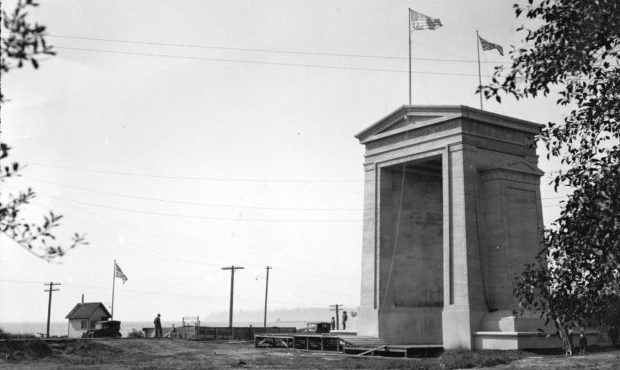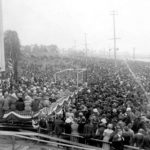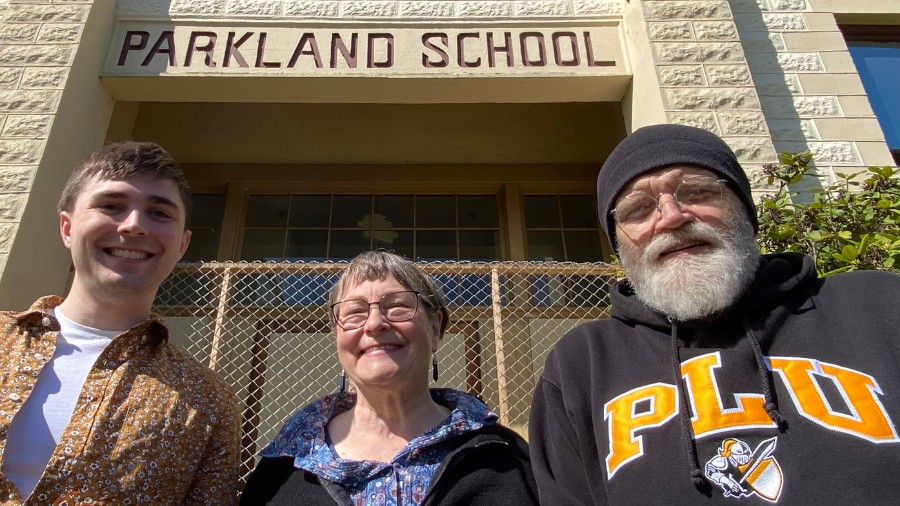Couples and families celebrate Peace Arch centennial in unexpected ways
Jul 21, 2021, 10:56 AM | Updated: Jul 23, 2021, 5:19 am
After almost a year and a half of being shut down to nearly everyone, the border between the United States and Canada is scheduled to reopen to fully vaccinated Americans on Aug. 9; Canadians headed south will have to wait until at least Aug. 21. Whenever the border does open, standing watch over the international crossing on Boundary Bay at Blaine that day – as it has for almost exactly a century – will be the Peace Arch.
The monument will officially turn 100 years old in early September, and while formal centennial celebration plans have evolved and mostly been put on hold, informal commemorations have been underway for most of the last year.
The 67-foot tall concrete Peace Arch straddles the border, with one of its two “legs” in Blaine, and the other in Surrey on the Canada/British Columbia side. In pre-pandemic times, groups of foreign tourists often arrived by bus to see the Peace Arch, while most Canadians and Washingtonians looked at it from their cars for only as long as they had to wait in line to cross the border.
Those who did visit for more than a drive by, found the monument surrounded by a lush Washington State Park on the south side and a BC Provincial Park on the north side. Together, the two plots of land create a single, contiguous park where visitors can actually temporarily cross into each country – as long as they remain within the boundaries of the park.
Inspiration for the monument came from the 1814 Treaty of Ghent, which ended the War of 1812, and which set the course for joint occupation of the Old Oregon Country by the United States and the British – though Indigenous people here had no say in the matter, of course. It also pays tribute to the thousands of miles of undefended border between the United States and Canada.
Industrialist and “good roads” promoter Samuel Hill – who also built other concrete monuments in Washington, including the Maryhill Museum and the Stonehenge replica near Goldendale – is credited with the idea to build the Peace Arch. The idea was hatched sometime around 1914 and the centennial of the Treaty of Ghent, but construction was delayed by World War I, and the so-called Spanish Flu pandemic then came right after that. The Peace Arch was finally dedicated with a series of public events on Sept. 6, 1921.
The monument was built at Blaine and Surrey because, of course, that’s where the border is. Blaine is also where the railroad between Canada and Washington first went through in February 1891, and where the main north-south highway connecting Canada and Washington was also dedicated in 1921.
With its picture-perfect setting and location on the border along the highway and a rail route, there have been a number of special events held at the monument and in the park over the years – including a big celebration in June 1946 marking the centennial of the Oregon Treaty, which, after decades of joint occupation, set the border at the 49th parallel.
The border-straddling park was also the site in the 1950s of a series of concerts by actor, singer, and labor activist Paul Robeson. Robeson was targeted by federal authorities during the Red Scare who revoked his passport; Robeson performed on the U.S. side to thousands in both this country and Canada. The Robeson concerts have come to be called the “Woodstock of the McCarthy Era.”
Before the pandemic hit, an entire season’s worth of special events had been planned for the year or so leading up to the Sept. 6, 2021, centennial. But, like so many best-laid plans since early 2020, the centennial commemoration has changed and evolved.
Christina Winkler is the distinctive monument’s greatest champion. She lives nearby, is president of the nonprofit International Peace Arch Association, and she works closely with officials on both sides of the still-closed border to help organize events and spread the word about the monument and the park.
Winkler loves the Peace Arch, and she sees a silver lining for the park – and for thousands of people – in the pandemic border closure.
“It is, in all honesty, the most visible, most known and yet under-interpreted international historic site in North America,” Winkler told KIRO Radio. “And so this whole pandemic has just reacquainted people with their park. It has brought people to come to understand it, [people] that [previously] just thought it was an extension of the border.”
“The pandemic itself has done such a great job in informing people about their park,” Winkler said.
Winkler points to countless stories from the past year about couples and families of all shapes and sizes from Canada and the United States – who are prevented by the border closure from visiting each other in their respective countries – meeting up in the park. With its unique configuration straddling the border, yet separate from customs or other official screenings, people from both countries who otherwise couldn’t get together can mix and meet up in the park, in spite of the border closure.
For Winkler – who lives and breathes all things Peace Arch – the meetings and family reunions that she’s witnessed over the past year or so have made a particular impact, and they’ve made her cry more times than she can count.
“I’ve met people from as far away from Florida who have flown in just to meet their family in the park,” Winkler said. “If you were to walk on one of the weekends in the last two or three months, you basically would see every culture you could imagine. You would see people with different faith backgrounds, different colors, and everybody coming together, for one reason, and that’s family.”
“It just has been one of the most beautiful experiences,” said Winkler, for someone “who’s been volunteering at the park for the last 25 years to actually see the best of humanity happening right in front of you.”
This “humanity” means a lot of grandparents and grandkids meeting for the first time, a lot of weddings – which, for history’s sake, Winkler wants to create a registry of. Nobody’s sure just how many nuptials have happened at the Peace Arch during the pandemic. One more thing that no one’s been counting: the tents set up by international couples for daytime private visits during the pandemic.
The Peace Arch obviously means a lot to Christina Winkler, and it and the community are all the better for her dogged drive and determination to honor and commemorate anniversaries and beat the drum about its significance. Volunteering for community projects is a good thing that many people do, of course. But for Winkler, it’s almost as if she is paying back the Peace Arch for what the silent monument did for her a quarter-century ago.
“We formed [the International Peace Arch Association] 26 years ago to commemorate the 75th anniversary of the Peace Arch,” Winkler said, admitting, “Yeah, well, it has been my passion, [but it was] unintended.”
Unintended?
“I went in to organize the 75th anniversary,” Winkler said, recalling when she first began volunteering. “Two weeks after it happened, my eldest child was killed — by a drunk driver — on his bicycle. And so somehow, Peace Arch stuff [gave me] things to do. Going from where we were, it just came natural, … it helped heal my heart.”
“And so every day that I can bring this [spirit] into the world,” Winkler said, “it’s a wonderful day.”
As odd as it sounds, Winkler credits the pandemic for making happen exactly what she has wanted to happen at the Peace Arch for years – for people on both sides of the border to intentionally visit, to spend time, and to make meaningful and lasting memories that are more than just driving by in bumper-to-bumper traffic and waiting to get through customs.
“It’s not just learning about a piece of history and going, ‘Oh well, that’s interesting. Gee!,’” Winkler said. “It’s their personal story, and so it’s exciting to think of where we can go with all the good for that park and for our relationship with Canada that has come out of this.”
Along with those wedding numbers, Winkler also wants to collect stories and photos of the past year, so that this distinctive era can be documented for future historians.
“We truly, truly are some of the most blessed people in the world, to share our border, to share our families, and to share our park with each other,” Winkler said. “Absolutely.”
Winkler says there might be some kind of modest commemoration of the centennial on Sept. 6, 2021 – maybe as simple as a flag-raising. She hopes to plan a full season of events for the year ahead, including a ceremony on Sept. 6, 2022.
Still, given the realities and limitations of the pandemic and the border closure, you couldn’t have designed a better way to commemorate the spirit of the Peace Arch than the way those thousands of families are making the most of the park – in the shadow of that 100-year-old monument – during the otherwise lonely and troubled months of the COVID-19 pandemic.
You can hear Feliks every Wednesday and Friday morning on Seattle’s Morning News, read more from him here, and subscribe to The Resident Historian Podcast here. If you have a story idea, please email Feliks here.






















